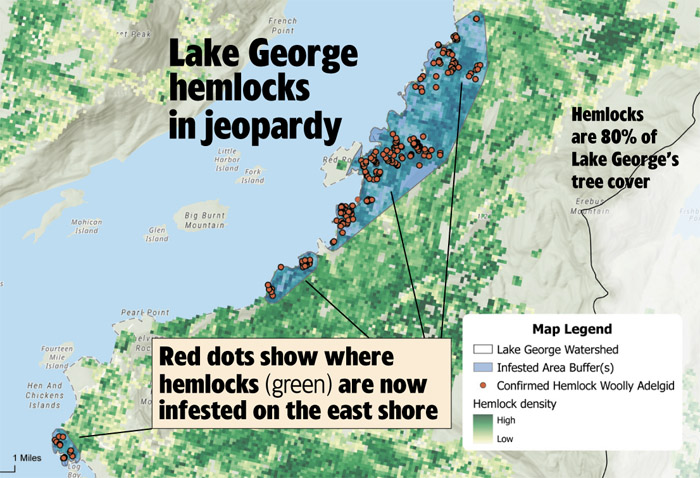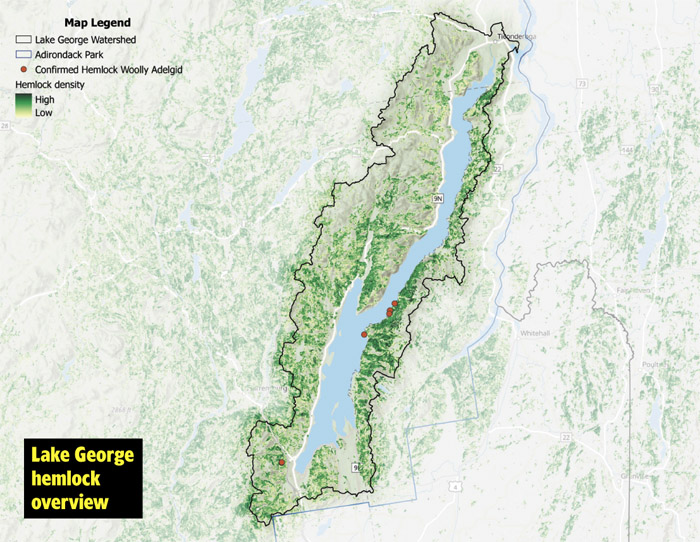High-gear task force mobilizes to eliminate LG invasive threat
By Mark Frost, Chronicle Editor

The FUND for Lake George has spearheaded quick formation of the “Save Our Lake George Hemlocks Initiative” in response to the new discovery that the invasive insect hemlock woolly adelgid infests trees on 250 acres of the lake’s east shore.
The effort will range, from five teams of three people each in the next two weeks treating infested trees one by one, to high-tech analysis of shades of green in satellite imagery of the forest canopy that may reveal trees in distress before the naked eye would notice it.

“Eighty percent of the forest around Lake George is hemlock. This is an incredibly important incident,” Rob Davies, New York State Forester and Director, Division of Lands and Forests for the Department of Environmental Conservation, told a virtual press conference on Tuesday.
He said, “We’ll be starting to treat in a matter of a week or two” with two “narrowly impactful” insecticides — “one fast-acting, one is a long-lasting prophylactic.”
Goal right away: ‘Knock it down’
“The goal this year is to knock it down,” Mr. Davies said. “We are absolutely confident we can control this infestation.”
He said the “five crews of three people who do the actual work” treating the trees include “one certified applicator, one who times it [the application of the treatment, and] someone who actually marks the trees as they go.
“We’re think it is going to take a two-week period.”
Eric Siy, executive director of the FUND for Lake George said in a press release, “Our goal is preventing the type of devastation that has ravaged millions of acres of hemlock stands in other parts of the country.”
“We’re not seeing significant decline in the health of the hemlock trees” in the newly found Lake George infestation, said Zack Simek, Conservation and GIS Analyst for the DEC-funded Adirondack Park Invasive Plant Program hosted by The Nature Conservancy’s Adirondack Chapter.
“It’s likely that these trees will recover over time.”
DEC’s Mr. Davies said the infestation of 250 acres is “larger than we had hoped” but “we do believe that is a good delineation of the current infested area.”
He said, “We do think the infestation is more than five years old at this point.”

Hemlock woolly adelgid was first discovered in 2017 on Prospect Mountain. The FUND said only “three trees” were found to be affected and the adelgid was eliminated.
Mr. Davies said, “We started surveying Lake George three years ago. Unfortunately we now know hemlock woolly adelgid was there but we didn’t find it.”
It was discovered this summer by a camper on the Black Mountain shoreline, in the Glen Island group of state campsites.
Mr. Davies credited the camper as a “citizen scientist” and noted “it takes a trained eye to find them. It is not easy to find.”
He emphasized the importance of public awareness and help in spotting the hemlock woolly adelgid and other invasives.
Noting the steep terrain and cliffs on the east shore of Lake George, Mr. Davies said, “This is not gonna be an easy area to treat,” but an advantage is that “the lighter infestation is inland and upland.”
Mr. Davies said the greater presence of the adelgid close to shore suggests that the bug was “spread by birds.”
The immediate focus was described as “over 150 hemlock stands of ecological and hydrological significance.”
Mr. Davies, in response to a reporter’s question about using certain insects that attack the hemlock woolly adelgid, said, “There is hope that we will actually be able to have some release of biocontrols” soon, but that there would need to be some surviving adelgids for it to work.
Mr. Zack said the biocontrol would be “a fly or a beetle.” Cornell has utilized the silver fly vs. the hemlock woolly adelgid in the Finger Lakes region of New York.
Mr. Siy said the immediate effort, which will continue into 2021, has a “total cost of $125,000.”
He said, “We’re laying the foundation for a longer term commitment. This isn’t a sprint. It’s a marathon.”
The press release from the Hemlock Initiative said, “Remote sensing satellites not only produce aerial photographic images but also capture infrared or near-infrared data that can reveal the level of photosynthetic activity [that] can provide evidence of declining forest health before that decline is apparent to the naked eye, making it much easier to direct ground crews to potential infestation sites.
“Later this month, the initiative’s experts will begin reviewing five years of remote sensing imagery and data for an approximately 4,400 square mile region, extending from the northern portion of the Lake George Watershed south to Troy in Rensselaer County, which, prior to the Lake George infestations, was the northernmost point of HWA detection in New York State.”
Mr. Simek said at the media event that they’re already thinking “how we can bring this project to scale all across the Adirondacks and even all of New York State.”
Along with The FUND, the Adirondack Park Invasive Plant Program and DEC, “the Lake George Land Conservancy, City University of New York’s Advanced Science Research Center, Cornell’s New York State Hemlock Initiative, U.S. Forest Service, Adirondack Research, among others” are involved, said the initial press release.
DEC asks public’s help
DEC asks the public to report signs of HWA (Hemlock Woolly Adelgid):
- Take pictures of the infestation signs (include something for scale such as a coin);
- Note the location (intersecting roads, landmarks, or GPS coordinates);
- Contact DEC or the local Partnership for Regional Invasive Species Management (PRISM) by visiting www.dec.ny.gov/animals/47433.html;
- Report the infestation to iMapInvasives at www.NYiMapInvasives.org; and
- Slow the spread of HWA by cleaning equipment or gear after it has been near an infestation and by leaving infested material where it was found.
Copyright © 2020 Lone Oak Publishing Co., Inc. All Rights Reserved.
 Glens Falls Chronicle Serving the Glens Falls/Lake George region; Warren, Washington and northern Saratoga counties since 1980
Glens Falls Chronicle Serving the Glens Falls/Lake George region; Warren, Washington and northern Saratoga counties since 1980

